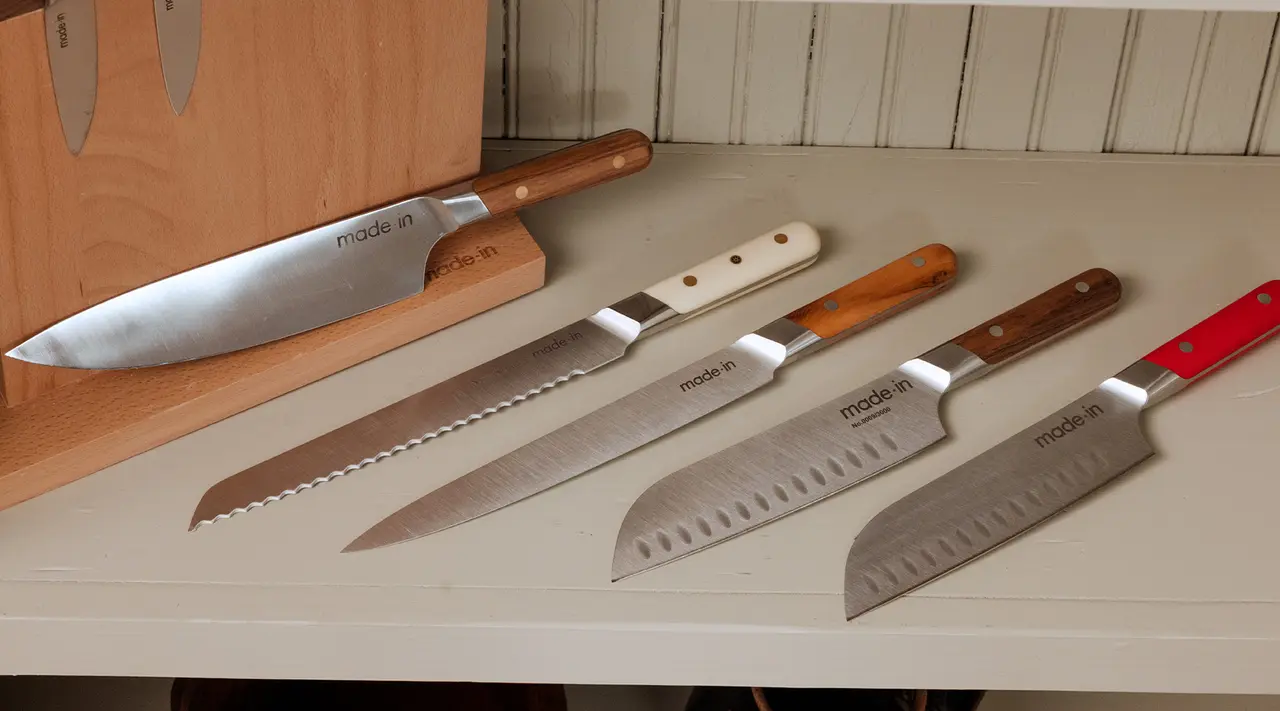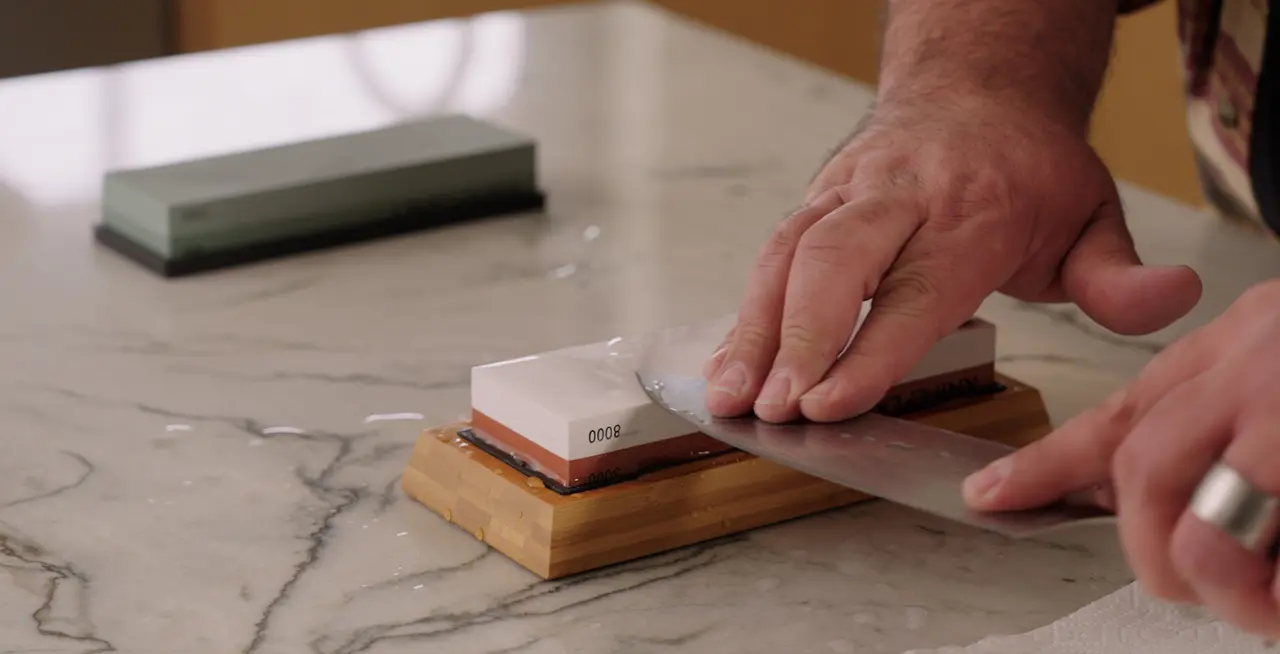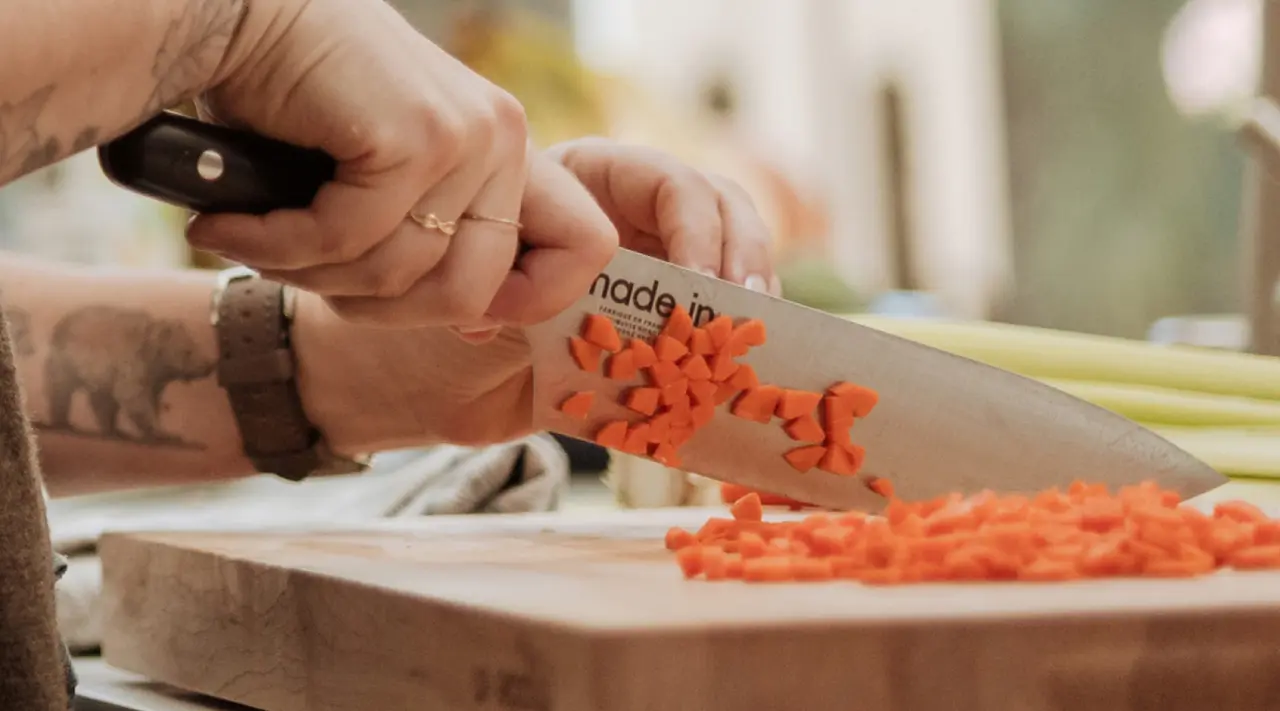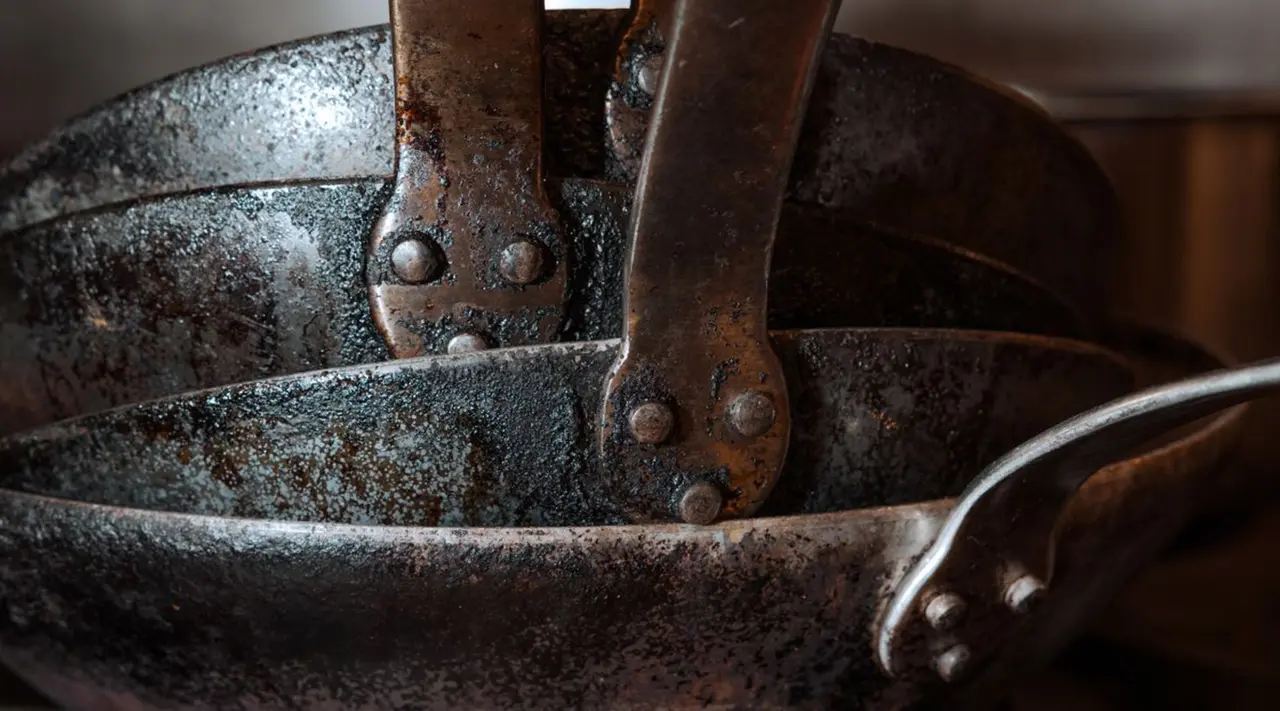Even a fully forged blade made from the hardest, most durable steel hardened with nitrogen available will eventually lose its edge—unless, of course, you keep it properly sharp and aligned.
Without further ado, here’s our 101 guide to knife sharpening: From the real differences between electric sharpeners and whetstones to how to hone your blade between sharpening sessions, here’s everything you need to know.
The Basics of Knife Sharpening

Try fileting raw salmon or—heavens forbid—cutting a kabocha squash with a dull knife, and you’ll find that rather than slicing cleanly through, your blade will simply press down on the food. This makes it hard to gain purchase and forces you to hack your way through the meat or vegetable. This is undesirable for a couple of reasons—the most important being that a dull knife forces you to exert more pressure, making it easier to slip and cut yourself, hence the old (but true) adage that a dull knife is more dangerous than a sharp one.
When we refer to sharpening, we’re talking about the process of grinding down the metal on the edge of your blade in order to refine and sharpen the cutting edge. This can be done using a variety of tools, the most popular being whetstones and sharpening rods.
Whetstone
This is far and away our preferred tool for sharpening knives. Also referred to as a sharpening stone, a whetstone resembles a long, thin brick made from synthetic materials like aluminum oxide or silicon carbide. While a bit difficult to get comfortable with, a whetstone gives you optimal control over the sharpening process, and is the recommended tool by many professional knife sharpeners.
Electric Sharpener
An electric sharpener is probably the most common sharpening tool, and we can understand why: they work quickly and require very little technique to use. That being said, these sharpeners can whittle your blade down to a nub if you’re not careful, which is why we recommend using a whetstone (or sending your blade to a professional sharpener) instead.
Sharpening Rod (or Honing Steel)
More accurately called a honing steel, this long, cylindrical metal tool is not technically used for sharpening at all—rather, you’ll use it to straighten out the edge of your blade, which can develop microscopic dings and dents over time, making it feel dull. Throughout the rest of the article, we’ll refer to this tool as a honing steel.
Knife Anatomy
If you’ve read this far down, you probably already know a thing or two on knife anatomy—but in case you don’t, here’s a brief rundown.
Edge: The cutting side of your blade, i.e. the section you’ll be honing or sharpening.
Handle: A handle is usually sandwiched by two pieces of slip-resistant material such as wood, rubber, or—in the case of our Chef Knives—POM, aka polyacetal. The handle should feel comfortable (and ideally, balanced) in the hand.
Spine: The smooth side, unsharpened side of the blade that runs parallel to the cutting side.
Tang: A solid piece of metal that extends down through the handle in order to provide balance and stability. In a full tang knife, the tang extends all the way through to the butt, or the base of the handle.
Honing vs. Sharpening
As we briefly touched on in our explanation of honing steels, there’s a big difference between sharpening and honing your knife. While honing simply straightens and realigns the blade’s microscopic teeth, sharpening involves physically grinding away thin layers of metal to expose a new, sharper edge. Typically, knives need to be honed more often than they need to be sharpened.
To determine whether your blade needs honing or sharpening, check out our dedicated piece on honing vs. sharpening with advice from Austin-based knife expert Sergio Menchaca.
Step-by-Step Guide to Knife Sharpening

To prepare your knife sharpening workspace, make sure you have a flat, level surface and a clean knife, as well as a cloth or dish towel to place under your whetstone.
How to Sharpen with a Whetstone
Step 1: Soak the Stone
Check the manual that came with your particular whetstone to see if your blade needs to be soaked prior to using, as some stones just need to be sprinkled with water (or even coated with oil). If yours requires soaking, submerge the stone in water for anywhere between 10 and 45 minutes, depending on manufacturer instructions.
Step 2: Set it Up
Set your whetstone down on a towel or dishcloth laid out on a flat surface, as this will keep it from slipping. Make sure the stone is perpendicular to your body, with one of the short sides facing you.
Step 3: Determine Your Bevel Angle
This is the angle at which your knife was originally sharpened, and it’s important to maintain that same angle whenever you sharpen it. Every knife has a slightly different bevel, but it’s usually somewhere between 15 and 20 degrees. Many whetstones come with a bevel guide, or angle guide, to help you find yours.
Step 4: Start Sharpening
Grip the handle with one hand, and rest the fingers of your other hand on the flat side of the blade (be careful!). Place the knife near the top of the stone with the blade facing toward you. Holding your blade at the correct angle, pull the knife down across the stone, using a slightly rounded motion to mimic the curved edge of the blade.
Step 5: Repeat
Using the same motion, repeat this process 10 to 20 times, or until a small fold of steel (or “burr”) forms at the edge of the blade. You should also see a layer of gray-looking water building up on the blade: this is from the miniscule amounts of blade material coming off on the stone. Make sure to remoisten your stone between strokes if it starts to feel a little dry.
Step 6: Sharpen the Other Side
Turn the knife so that the opposite side of the blade is now resting on the stone. Instead of starting at the top of the stone, place the heel of the blade near the base. Repeat steps 2 through 5 on this side.
Step 7: Switch to a Finer Grit
Now that you’ve formed the angle on your blade, it’s time to polish and refine it. Either flip your stone to the finer grit side, or switch over to a separate, finer grit stone (pre-soaked, of course). Repeat steps 3 through 6.
For a more in-depth guide to whetstone sharpening—including additional tips for finding the angle of your knife’s bevel—check out our dedicated post on whetstone sharpening.
How to Sharpen with an Electric Sharpener
Here’s a step-by-step guide to setting up and using the Work Sharp electric sharpener, aka Menchaca’s preferred electric sharpener.
- Assemble the sharpener according to the manufacturer’s instructions: If the machine comes with multiple grit levels, choose a coarse or medium-coarse grit.
- Rest the blade on the right side of the sharpener, making sure that it’s aligned with the angle and edge guides.
- Holding the power switch, pull the knife straight through from heel to tip: An 8” blade should take roughly 3 to 4 seconds per stroke to sharpen.
- Release the power switch once the tip of the blade reaches the center of the belt.
- Repeat this process 5 to 10 times, or until you notice a burr beginning to form on the opposite side of the blade.
- Flip the blade and repeat steps 2 through 5 using the left side of the sharpener.
How to Hone Your Knife

Next to sharpening, honing is a pretty straightforward process. First, place the tip of the steel on a non-slip surface (such as on a sturdy dish towel). Gripping the handle, glide the edge of the blade down the length of the steel, with the blade at a 15 to 20 degree angle. You should feel the blade “catch,” or resist the honing steel. This means that the steel is doing its work of straightening out the blade.
Do this about five times on each side, and repeat as necessary.
Additional Sharpening Methods
Aside from a whetstone, electric sharpener, and honing steel, there is one other, less common tool you can use for refining your blade: the strop. This tool—usually made from leather affixed to a wooden board—is used to polish and perfect your blade after sharpening. You definitely don’t have to run out and buy a strop if you don’t already have one, though—a whetstone (with both fine grit and coarse grit sides) or electric sharpener and a honing steel should be all you need.
How to Choose the Right Sharpening Tools

Choosing the right tool to get your knife sharp can feel overwhelming, especially if you’re new to the world of sharpening. Here’s how to choose the right one for you.
Whetstone
Whetstones come in a variety of different grit levels, ranging from coarse to extremely fine. Typically, a whetstone will come with a number that denotes how coarse or fine it is: the lower the number, the coarser the grit, and vice versa.
Many stones come with two sides: a coarse side, for forming the bevel—or angle—of the blade, and then a finer side for buffing and finishing it. A good place to start is with an 800-1000 grit stone—i.e. a coarser grit—and then moving to a grit of 3000 or higher for finishing.
Honing Steel
Honing steels (formerly/inaccurately known as sharpening rods) come in a few different materials, with stainless steel, Tungsten steel, diamond-coated steel, and ceramic being some of the most common.
Electric Knife Sharpener
Often thought of as an easier version of a whetstone, an electric knife sharpener offers a quick, easy way to sharpen your knives at home. Just be aware, however, that electric sharpeners are harsher on your blade, and can even wear a hole in the metal if you’re not careful.
Additional Knife Sharpening Tips

Now that you’re familiar with the basics of knife sharpening, here are some additional tips for keeping your knives in tip-top condition.
How to Test the Sharpness of Your Knife
To check whether your knife needs sharpening, there are a couple of “tests” to try— namely, the tomato test and the paper test.
Paper Test
Hold a piece of printer paper in the air. With your knife, carefully try slicing through the paper. If you’re unable to slice cleanly through without too much effort, your knife is too dull.
Tomato Test
Place a whole tomato on a cutting board and using a gentle, fluid motion, try slicing through with your knife. The blade should easily pierce the skin and produce a clean slice: if not, it’s time for a sharpening session.
How to Keep Your Blade Sharp Between Sharpening Sessions
- Make sure to use the right cutting board material. We recommend using something firm but still relatively soft, like wood or plastic, versus a hard material like glass or marble. A hard cutting board is tougher on your blade, causing it to dull faster.
- Always hand wash. Dishwashing will dull and ding your blade, and can also damage certain types of handle materials. Dry thoroughly after washing.
- Store your knife in a knife block, in-drawer knife organizer, or on a magnetic knife strip—never loose in a drawer. Not only is this dangerous, but it can also cause your knife to bump up against other items and create dents and dings. Even if you just use a wooden sheath or plastic blade guard to protect the blade, that’s better than no protection at all.
Ready to Chop?
Whether it’s a great chef knife, a sturdy roasting pan, or an heirloom-worthy skillet, quality cookware is a crucial part of making delicious food. But even the best tools need a little upkeep: That’s why we’re constantly stressing the importance of a sharp knife, and why we want you to feel confident enough to sharpen—or at least hone—your own blade.
Of course, it helps to have a knife that keeps its edge for months at a time without sharpening. If you’re currently shopping for your first chef knife—or for a new one to add to your collection—our line of fully forged, full tang Chef Knives combine professional quality with beginner-friendly design.
































